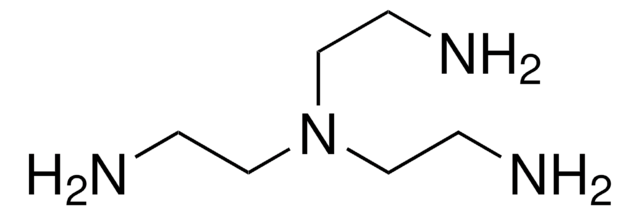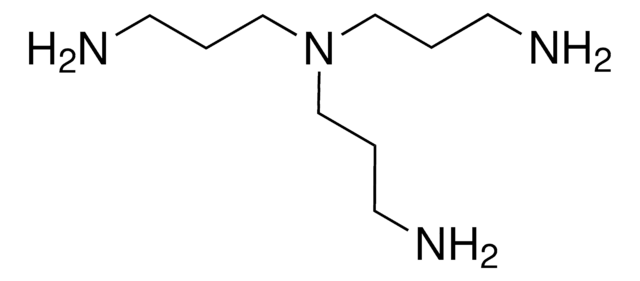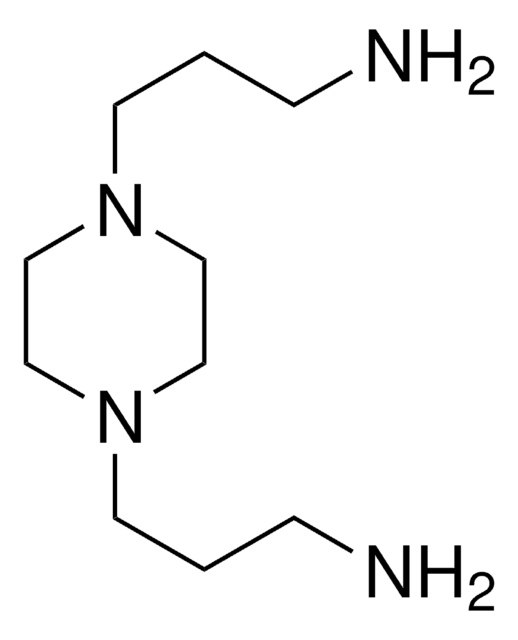188441
3,3′-Diamino-N-methyldipropylamine
96%
Synonyme(s) :
(7-Amino-4-methyl-4-azaheptyl)amine, 1,7-Diamino-4-aza(methyl)heptane, 1,7-Diamino-4-methyl-4-azaheptane
About This Item
Produits recommandés
Pression de vapeur
6 mmHg ( 110 °C)
Pureté
96%
Forme
liquid
Indice de réfraction
n20/D 1.4725 (lit.)
Point d'ébullition
110-112 °C/6 mmHg (lit.)
Densité
0.901 g/mL at 25 °C (lit.)
Chaîne SMILES
CN(CCCN)CCCN
InChI
1S/C7H19N3/c1-10(6-2-4-8)7-3-5-9/h2-9H2,1H3
Clé InChI
KMBPCQSCMCEPMU-UHFFFAOYSA-N
Application
- new bischromone derivatives, potential anticancer drugs
- polyamine derivatives containing dimeric quinolone, cinnoline and phthalimide moieties
- 3-(2,4-dinitroanilino)-3′-amino-N-methyldipropylamine
Mention d'avertissement
Danger
Mentions de danger
Classification des risques
Acute Tox. 1 Inhalation - Acute Tox. 3 Dermal - Acute Tox. 4 Oral - Eye Dam. 1 - Skin Corr. 1B
Code de la classe de stockage
6.1A - Combustible acute toxic Cat. 1 and 2 / very toxic hazardous materials
Classe de danger pour l'eau (WGK)
WGK 1
Point d'éclair (°F)
217.4 °F - closed cup
Point d'éclair (°C)
103 °C - closed cup
Équipement de protection individuelle
Faceshields, Gloves, Goggles, type ABEK (EN14387) respirator filter
Certificats d'analyse (COA)
Recherchez un Certificats d'analyse (COA) en saisissant le numéro de lot du produit. Les numéros de lot figurent sur l'étiquette du produit après les mots "Lot" ou "Batch".
Déjà en possession de ce produit ?
Retrouvez la documentation relative aux produits que vous avez récemment achetés dans la Bibliothèque de documents.
Les clients ont également consulté
Notre équipe de scientifiques dispose d'une expérience dans tous les secteurs de la recherche, notamment en sciences de la vie, science des matériaux, synthèse chimique, chromatographie, analyse et dans de nombreux autres domaines..
Contacter notre Service technique


![Tris[2-(methylamino)ethyl]amine 97%](/deepweb/assets/sigmaaldrich/product/structures/217/368/3e89e134-669e-4a03-9a34-f97b50399bb2/640/3e89e134-669e-4a03-9a34-f97b50399bb2.png)


![Tris[2-(dimethylamino)ethyl]amine 97%](/deepweb/assets/sigmaaldrich/product/structures/695/792/ee0ff167-22a3-43a7-83a1-6c4908adf0ae/640/ee0ff167-22a3-43a7-83a1-6c4908adf0ae.png)




